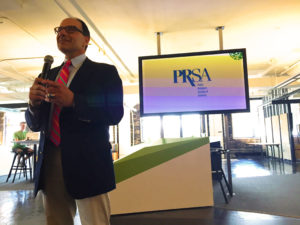Last week Joe Truncale, CEO of the Public Relations Society of America (PRSA), visited Minnesota chapter members in downtown Minneapolis. Spong PR hosted the event.
In his presentation, Truncale explained what he had learned about PRSA’s infrastructure after becoming CEO, and discussed upcoming changes in the organization. His most important learnings were: the areas of improvement for PRSA’s website (and the chapter websites), how to increase PRSA membership, and the need for synergy between the national office and the 10 regional districts.
Truncale was enthusiastic to tell us about the changes currently underway with the national PRSA website. He said that in order to create uniformity, PRSA will be rolling out three levels of chapter website templates that align with the national website.
Instead of staying with the company that designed the previous website, PRSA executives have chosen a new company to design the new website. Truncale touched on the importance of this, and how in an always-changing digital environment, embracing the new is critical. He compared PRSA’s current website to a house being redesigned on HGTV: the problem with the website couldn’t be fixed with a simple paint job or a couple of cosmetic retouches; it needed to be gutted out and completely remodeled. He emphasized that the new website is mobile friendly and easy to use. The new website will be unveiled in October.
PRSA membership seemed to be one of Truncale’s favorite topics of the night. Membership is static, which (he sees) as room for improvement. What I found to be surprising and exciting was the weight he gave to PRSSA members. He emphasized just how critical transitioning PRSSA to PRSA membership was for aspiring PR professionals, and for the organization as a whole. I am not currently a PRSSA member, but I have often considered joining. For me, seeing the care that PRSA’s leader has for young professionals was motivating and encouraging.
As he has been traveling around the country attending chapter meetings, Truncale is always told, “Thank you for coming.”
He chuckled to us and said, “Thank me? I should be thanking you. You’re the volunteers, you’re the people that put programs like this together, that keep chapters alive. You keep the member experience at a very very high level. I’m happy to come and visit our members — why wouldn’t I come?”
It was easy to see Truncale’s dedication to “being on the ground” with PRSA members when he could.
As a student still frequently exposed to new leadership styles, it was enlightening to see a CEO working so hard to connect with as many organization members as possible. Part of these actions is fueled by his desire to connect executive officers with chapter members. He has hired regional representatives to help achieve this goal. It it my understanding that these representatives would ensure communication and understanding between the national office and the chapters. It is his belief that executives should be closer to the members, both geographically and technologically.
The presentation ended with a touch of inspiration. He wants PRSA to focus on what it is best at, and to profit from its obvious strengths. Truncale also revealed that innovation is what we have to look forward to from PRSA in the near future. He told us that this is what people expect from the future of PRSA, and that by playing to the organization’s strengths, and adjusting areas of growth, such innovation can be achieved.
Further national PRSA issues will be discussed this October at the PRSA National Assembly and International Conference in Indianapolis.

